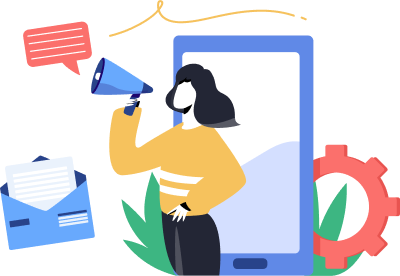Why Turn Form Submissions into Landing Pages? Many companies receive form submissions that contain valuable content rather than just lead..

Marketing Personalization Examples in HubSpot (+ Checklist)
Personalized marketing is no longer a luxury; it's now a necessity for businesses to stay ahead of the competition. As a B2B marketer, you must provide your audience with relevant, engaging, and tailored content. HubSpot is one of the leading platforms for achieving this goal. In this blog post, we'll explore personalized marketing, why it's valuable, its challenges, and how HubSpot can help you overcome these challenges to succeed in marketing personalization.
What is personalized marketing?
Personalized marketing, or one-to-one marketing, involves leveraging data and technology to create targeted, individualized experiences for each customer or prospect. This type of marketing aims to deliver the right message to the right person at the right time, leading to better engagement and, ultimately, higher conversions.
In B2B marketing, personalized marketing is about understanding your target audience, their needs, pain points, and preferences and tailoring your communication, content, and offers to address those needs.
Why is personalized marketing valuable?
Personalized marketing offers several benefits for B2B organizations, including:
- Improved customer experience: By providing relevant and tailored content, you enhance the overall customer experience, leading to higher satisfaction and brand loyalty.
- Increased engagement: Personalized marketing messages are more likely to resonate with your audience and drive higher engagement levels, increasing click-through rates, open rates, and conversions.
- Higher ROI: With targeted marketing efforts, you can ensure that your marketing budget is spent more efficiently, leading to better returns on investment.
- Competitive advantage: Personalized marketing helps you differentiate yourself from competitors and stay ahead of the curve in an increasingly competitive marketplace.
What makes marketing personalization so difficult?
Several challenges can make marketing personalization a daunting task for B2B marketers, including:
- Data management: Collecting, organizing, and analyzing customer data from various sources can be a complex and time-consuming process.
- Content creation: Developing tailored content for various segments of your target audience requires significant resources and effort.
- Technology integration: Seamless integration with marketing tools and technologies is essential for successful personalization, which can challenge organizations with disparate systems.
- Privacy concerns: Personalization relies on personal data, leading to privacy and security concerns if not managed correctly.
Personalized marketing examples that can be achieved using HubSpot
HubSpot is an all-in-one marketing platform that offers various tools and features to help B2B marketers achieve marketing personalization. Some examples include:
- Personalized email campaigns: With HubSpot's email marketing tool, you can segment your contact list based on various criteria, such as industry, job title, or previous interactions, and send targeted email campaigns with personalized content and offers. [Read: The Difference Between Good and Bad Email Personalization]
- Dynamic content on websites: HubSpot's CMS allows you to create dynamic web pages that display different content based on a visitor's characteristics or behavior. This enables you to deliver a customized experience for each user, enhancing engagement and conversions.
- Lead nurturing workflows: HubSpot's Marketing Automation tool enables you to create personalized lead nurturing workflows that guide prospects through the buyer's journey by sending targeted content and offers based on their interests, behavior, and buying readiness.
- Personalized CTAs: With HubSpot's Call-to-Action (CTA) tool, you can create CTAs that change based on the visitor
Here's your Personalization in HubSpot Checklist:
1. Establish your goals and objectives:
- Define the purpose of personalization for your B2B marketing strategy.
- Identify key performance indicators (KPIs) to measure success.
- Segment your contacts based on demographics, firmographics, and behavior.
- Develop buyer personas to understand your target audience better.
- Integrate CRM, marketing, and sales data to create a holistic view of your audience.
- Regularly clean and update contact information to ensure data accuracy
- Enable tracking codes on your website, emails, and forms to collect user behavior data.
- Leverage HubSpot's analytics tools to monitor user engagement
- Use Contact Properties, Custom Properties, and Smart Lists to store and organize data for personalization.
- Set up Smart Content for personalized web pages, CTAs, and forms.
- Use Personalization Tokens to insert contact information into email subject lines and body text.
- Segment your email lists based on audience attributes and behaviors.
- Implement A/B testing to optimize email campaigns.
- Use Smart content to display tailored messaging, images, and CTAs based on user attributes and behaviors.
- Personalize landing pages and forms to improve conversion rates
- Implement adaptive menus and recommendations to guide users through the buyer's journey.
- Customize chatbot messaging and workflows based on user attributes and behaviors.
- Integrate chatbots with CRM and sales systems to provide personalized support and recommendations.
- Regularly review KPIs to measure the effectiveness of your personalization efforts.
- Use HubSpot's analytics and reporting tools to identify areas for improvement.
- Use the insights gained from analytics to refine your personalization strategy.
- Test new personalization tactics and adjust your approach as needed.
- Stay current with HubSpot updates and industry trends to maximize your personalization efforts.
- Air Traffic Control automatically recommends your content, whether it's on HubSpot's CMS or anywhere else, for each contact based on their interests.
Remember, personalization is an ongoing process that requires continuous optimization, testing, and learning. By following this checklist, you'll be well on your way to creating a more engaging and effective B2B marketing strategy using HubSpot's personalization tools.

Subscribe to the
Air Trafic Control newsletter
Receive regular tips and resources to boost your establishment!
Related Blogs
We have something for everyone on our blog. Dig in!
In today's digital-first B2B landscape, understanding buyer intent has become more crucial—and more complex—than ever. As buying committees..
Personalization is no longer optional – it’s expected. Tailoring your website’s content to the specific needs and interests of each visitor..
